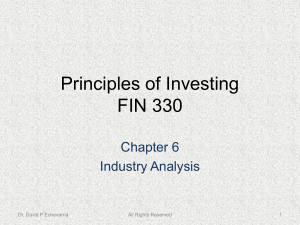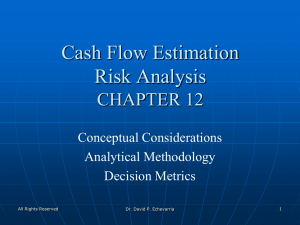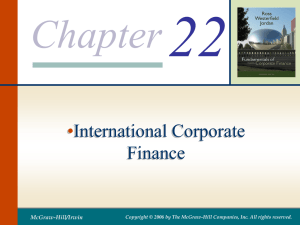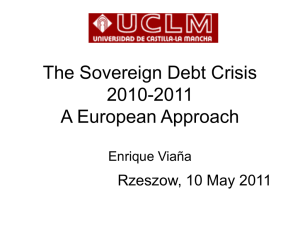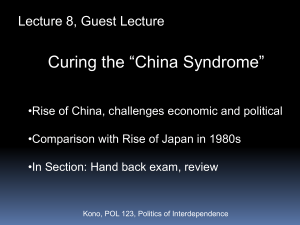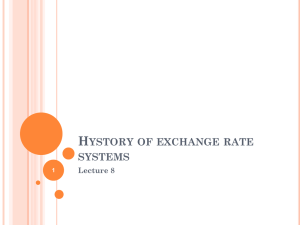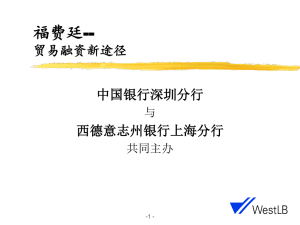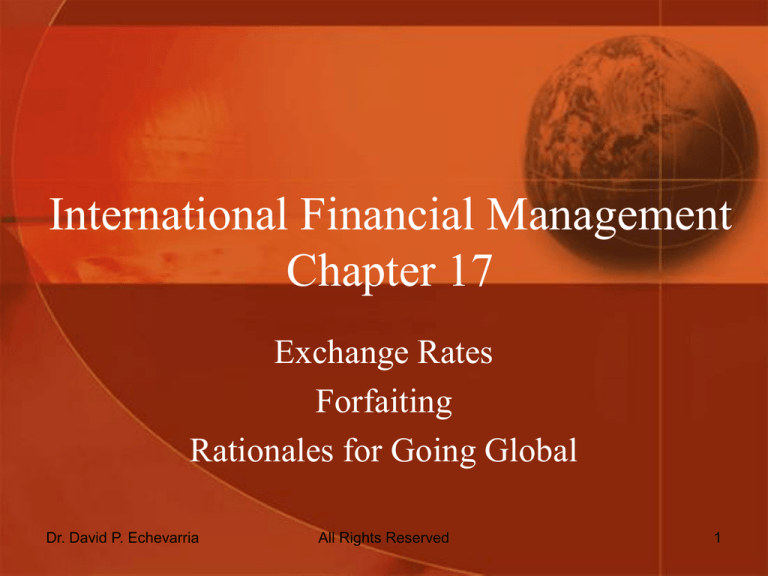
International Financial Management
Chapter 17
Exchange Rates
Forfaiting
Rationales for Going Global
Dr. David P. Echevarria
All Rights Reserved
1
INTERNATIONAL FINANCE
TERMINOLOGY
A.
B.
C.
D.
E.
F.
American Depositary Receipt (ADR)
Currency Cross-rate table
Eurobond
Eurocurrency (Eurodollars)
London Interbank Offer Rate (LIBOR)
Swaps
1. Interest rate (fixed for variable)
2. Currency (dollars for yen)
Dr. David P. Echevarria
All Rights Reserved
2
EXCHANGE RATES
A.
The price of one country’s currency in terms of another
1.
2.
B.
C.
Direct quotes: how much to buy a foreign currency?
Indirect quotes: how much of our currency will a unit of foreign
currency buy?
Many currencies quoted in terms of dollars (direct quotes)
Consider the following quote:
1.
2.
3.
4.
Euro
1.3397
.7465
The first number (1.3397) is how many U.S. dollars it takes to buy 1
euro (direct quote)
The second number (. 7465) is how many Euros it takes to buy
U.S.$1 (indirect quote)
The two numbers are reciprocals of each other (1/. 7465 = 1.3397)
Dr. David P. Echevarria
All Rights Reserved
3
EXCHANGE RATES
D. Example 1: Exchange Rates
1. Suppose you have $10,000 . How many Norwegian
Krone can you buy? (4/26/2011 rates)
2. Exchange rate = 5.3478 Krone per U.S. dollar
3. Buy 10,000(5.3478) = 53,478 Krone
E. Example 2: Exchange rates
1. Suppose you are visiting London and you want to buy a
souvenir that costs 1,000 British pounds. How much does
it cost in U.S. dollars? (4/26/2011 rates)
2. Exchange rate = $1.6478 dollars per pound
3. Cost = 1,000 x 1.6478 = $1,647.80
Dr. David P. Echevarria
All Rights Reserved
4
EXCHANGE RATES
F. Example 3: Triangle Arbitrage
1. We observe the following fictitious quotes:
1.
a.
b.
1 Euro per $1
2 Swiss Franc per $1
.4 Euro per 1 Swiss Franc
2. What should the Euro/SF cross rate be?
a.
(1 Euro / $1) / (2 SF / $1) = .5 Euro / SF (a mispricing)
3. How can we profit from the mispricing? We have $1000
to invest (buy the low, exchange to the high)
a.
b.
c.
d.
Exchange $1000 for Euros (@ $1 = E1) = 1000 Euro
Exchange 1000 Euro (@ .4 Euro = 1 SF) = 2500 SF
Exchange 2500 SF for $/ (@ 2 SF = $1) = $1250
You used a mispricing in the markets to make $250 risk-free
Dr. David P. Echevarria
All Rights Reserved
5
TRANSACTION TERMINOLOGY
A. Spot trade – exchange currency immediately
1. Spot rate – the exchange rate for an immediate trade
B. Forward trade – agree today to exchange currency
at some future date and some specified price (also
called a forward contract)
1. Forward rate – the exchange rate specified in the forward
contract
C. If the forward rate is higher than the spot rate, the
foreign currency is selling at a premium (when
quoted as $ equivalents)
D. If the forward rate is lower than the spot rate, the
foreign currency is selling at a discount
Dr. David P. Echevarria
All Rights Reserved
6
TRANSLATION EXPOSURE
Income from foreign operations must be translated
back to U.S. dollars for accounting purposes, even
if foreign currency is not actually converted back to
dollars
A. Managing Exchange Rate Risk
1. Large multinational firms may need to manage the
exchange rate risk associated with several different
currencies
2. The firm needs to consider its net exposure to currency
risk instead of just looking at each currency separately
3. Hedging individual currencies could be expensive and
may actually increase exposure
Dr. David P. Echevarria
All Rights Reserved
7
TRANSLATION EXPOSURE
B. Political Risk
1. Changes in value due to political actions in the foreign
country
2. Investment in countries that have unstable governments
should require higher returns
3. The extent of political risk depends on the nature of the
business
4. The more dependent the business is on other operations
within the firm, the less valuable it is to others
5. Natural resource development can be very valuable to
others, especially if much of the ground work in
developing the resource has already been done
6. Local financing can often reduce political risk
Dr. David P. Echevarria
All Rights Reserved
8
FORFAITING
(Medium-Term Capital Goods Financing)
A. Forfaiting means selling a bill of exchange, at a
discount, to a third party, the forfaiter.
B. The forfaiter collects the payment from an overseas
customer, through a collateral bank(s)
C. The forfaiter assumes the underlying responsibility
of exporters and simultaneously providing trade
finance for importers by converting a short-term
loan to a medium term one.
D. Forfaiting is the discounting of international trade
receivables on a without recourse basis.
Dr. David P. Echevarria
All Rights Reserved
9
FORFAITING
(Medium-Term Capital Goods Financing)
E. Characteristics:
1. The exporter extends credit for period ranging
between 180 days to 7 years.
2. Minimum bill size should be US$ 250,000 (US$
500,000/- is preferred)
3. The payment should be receivable in any major
convertible currency.
4. A Letter of Credit, or a guarantee by a bank,
usually in importer's country.
5. The contract can be for either goods or services.
Dr. David P. Echevarria
All Rights Reserved
10
FORFAITING
(Medium-Term Capital Goods Financing)
F. Documentation:
At its simplest, the receivables must be
backed by any of the following debt
instruments:
1.
2.
3.
4.
Promissory Note (~ a note payable)
Bills of Exchange
Deferred payment letter of credit
A [bank] letter of guarantee
Dr. David P. Echevarria
All Rights Reserved
11
FORFAITING
(Medium-Term Capital Goods Financing)
G. Pricing
1. Discount Rate: LIBOR plus margin
2. Days of Grace: cover b-days until settlement
3. Commitment Fee: ~ to cover exposure days
H. Benefits:
1. Eliminates risks like political, transfer and commercial
risks
2. Enhances competitive advantage.
a.
b.
Ability to provide vendor financing making products more
attractive
Enables the exporter to do business in risky countries.
3. Increases cash flow. Forfaiting converts a credit-based
transaction in to a cash transaction.
Dr. David P. Echevarria
All Rights Reserved
12
ABSOLUTE PURCHASING POWER
PARITY
A. Price of an item is the same regardless of the
currency used to purchase it
B. Requirements for absolute PPP to hold
1. Transaction costs are zero
2. No barriers to trade (no taxes, tariffs, etc.)
3. No difference in the commodity between
locations
4. Absolute PPP rarely holds in practice for many
goods
Dr. David P. Echevarria
All Rights Reserved
13
RELATIVE PURCHASING POWER
PARITY
Provides information about what causes
changes in exchange rates
A. The basic result is that exchange rates
depend on relative inflation between
countries
B. E (St) = S0 [1 + (hFC – hUS)]t
C. Because absolute PPP doesn’t hold for many
goods, we will focus on relative PPP from
here on
Dr. David P. Echevarria
All Rights Reserved
14
RELATIVE PURCHASING POWER
PARITY
D. Example: PPP
1. Suppose the Canadian spot exchange rate is 1.18
Canadian dollars per U.S. dollar. U.S. inflation is
expected to be 3% per year and Canadian inflation is
expected to be 2%.
2. Do you expect the U.S. dollar to appreciate or depreciate
relative to the Canadian dollar?
3. Since expected inflation is higher in the U.S., we would
expect the U.S. dollar to depreciate relative to the
Canadian dollar.
4. What is the expected exch. rate in one year?
5. E(S1) = 1.18[1 + (.02 - .03)]1 = 1.1682
Dr. David P. Echevarria
All Rights Reserved
15
QUESTIONS YOU SHOULD BE ABLE
TO ANSWER
A. What does an exchange rate tell us?
B. What is triangle arbitrage?
C. Comprehensive Problem
1. Assume that one U.S. dollar buys 81.748 Japanese Yen,
and one U.S. dollar buys .60687 Pound Sterling.
2. What must the Yen – pound exchange rate be in order to
prevent triangular arbitrage (ignoring transaction costs)?
D. What is forfaiting and how is it used?
Dr. David P. Echevarria
All Rights Reserved
16
HOMEWORK CHAPTER 17
A. Self-Test: ST-1, d, e, h, j, k, m, p
B. Questions: 17-1, 17-2, 17-4, 17-5
C. Problems: 17-1, 17-2, 17-3, 17-7
Dr. David P. Echevarria
All Rights Reserved
17
COVERED INTEREST ARBITRAGE
A. How can we take advantage of differences in
interest rates to earn risk free returns?
B. Examine the relationship between spot rates,
forward rates, and nominal rates between 2
countries
1. Again, the formulas will assume that the
exchange rates are quoted in terms of foreign
currency per U.S. dollar
2. The U.S. risk-free rate is assumed to be the T-bill
rate
Dr. David P. Echevarria
All Rights Reserved
18
COVERED INTEREST ARBITRAGE
C. Example: Covered Interest Arbitrage
1. Consider the following information
a.
b.
S0 = .8 Euro / $
F1 = .7 Euro / $
RUS = 4%
RE = 2%
2. What is the arbitrage opportunity?
a.
b.
c.
d.
e.
f.
Borrow $100 at 4%
Buy $100(.8 Euro/$) = 80 Euro and invest at 2% for 1 year
Open [“Buy”] a Euro forward contract (.7 Euro = $1)
In 1 year, receive 80 * (1.02) = 81.6 Euro and convert back to
dollars (exercise the forward contract)
81.6 Euro / (.7 Euro / $) = $116.57 and repay loan
Profit = 116.57 – 100 * (1.04) = $12.57 risk free
Dr. David P. Echevarria
All Rights Reserved
19
COVERED INTEREST ARBITRAGE
D.
Interest Rate Parity
1.
2.
E.
Based on the previous example, there must be a forward rate that
would prevent the arbitrage opportunity.
Interest rate parity defines what that forward rate should be
Short-Run Exposure
1.
2.
Risk from day-to-day fluctuations in exchange rates and the fact that
companies have contracts to buy and sell goods in the short-run at
fixed prices
Managing risk
a.
b.
Enter into a forward agreement to guarantee the exchange rate
Use foreign currency options to lock in exchange rates if they move
against you, but benefit from rates if they move in your favor
Dr. David P. Echevarria
All Rights Reserved
20
COVERED INTEREST ARBITRAGE
E. Long-Run Exposure
1. Long-run fluctuations come from unanticipated
changes in relative economic conditions
2. Could be due to changes in labor markets or
governments
3. More difficult to hedge
4. Try to match long-run inflows and outflows in
the currency
5. Borrowing in the foreign country may mitigate
some of the problems
Dr. David P. Echevarria
All Rights Reserved
21


